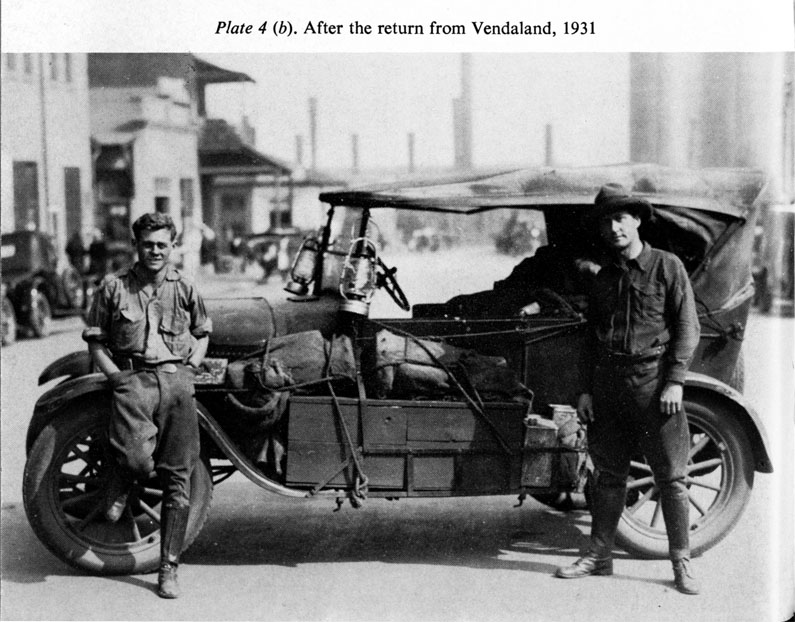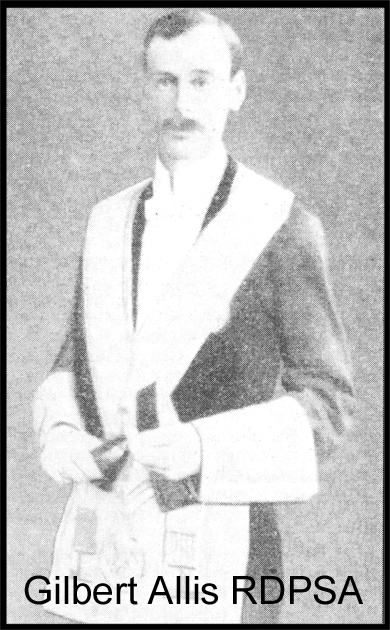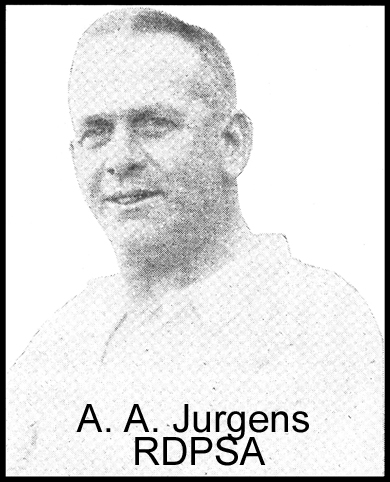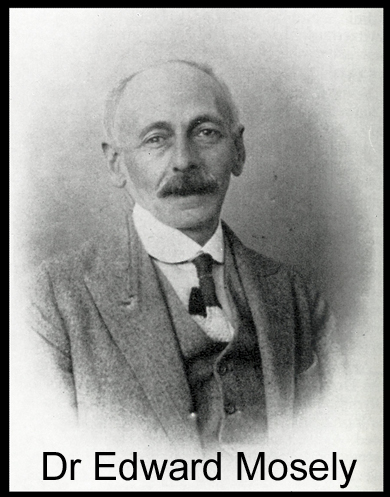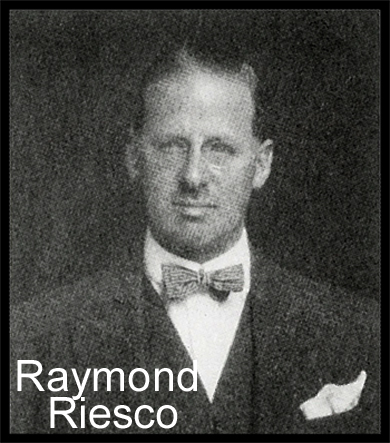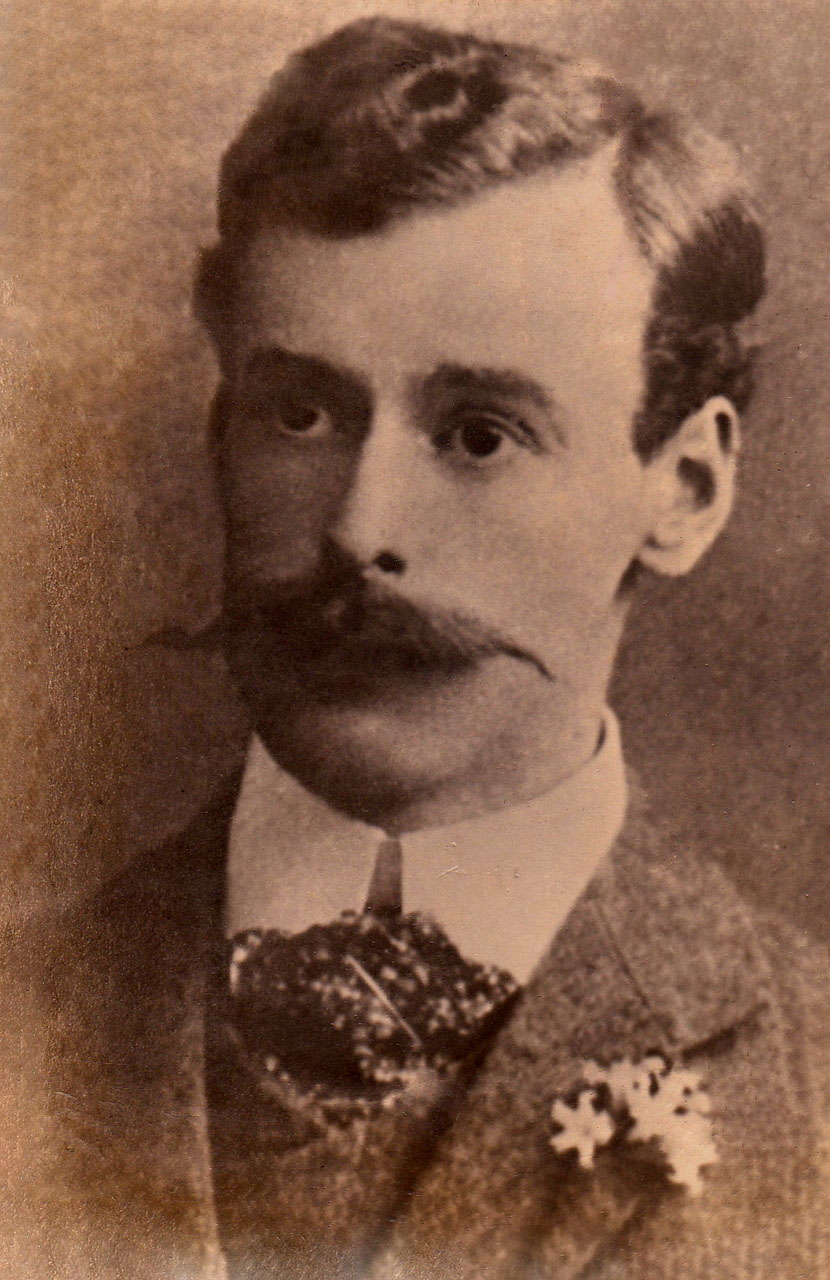Photos of SA Postal Historians
Quote from Steve on August 31, 2020, 6:29 pmIn posting on the 'South African War Trains, Cavalcades and Victory Fairs' thread I mentioned Dr Hasso Resisener's Book, the 'Special and Commemorative Postmarks, Cachets....' in regard to my postcard from Pinelands 18th Century Fair whose aim was to raise money for the Victory War Effort in 1940. Reisener's reference to my postcard appears on the same page in his book as the 'War Train'. I include a photo here of the young Hasso Reisener, (left below), when he was still a student at Wits. Hasso is standing at the front of the Model T Ford in which he journeyed to Sekhukhuneland (later Vendaland) with Prof. Percival Kirby, (right) of the Dept. of African Music. Kirby was a Scot and a great South African musicologist and ethnomusicologist. His Kirby Collection of priceless African musical instruments is now housed in the SA College of Music, UCT. In his retirement in Grahamstown, Kirby became the leading authority on the wreck of the Grosvenor on the Pondoland coast in 1782. Hasso made a great name for himself as a larger than life character who also happened to be a a postal historian. The photo is from Kirby's autobiography, 'Wits End'.
In posting on the 'South African War Trains, Cavalcades and Victory Fairs' thread I mentioned Dr Hasso Resisener's Book, the 'Special and Commemorative Postmarks, Cachets....' in regard to my postcard from Pinelands 18th Century Fair whose aim was to raise money for the Victory War Effort in 1940. Reisener's reference to my postcard appears on the same page in his book as the 'War Train'. I include a photo here of the young Hasso Reisener, (left below), when he was still a student at Wits. Hasso is standing at the front of the Model T Ford in which he journeyed to Sekhukhuneland (later Vendaland) with Prof. Percival Kirby, (right) of the Dept. of African Music. Kirby was a Scot and a great South African musicologist and ethnomusicologist. His Kirby Collection of priceless African musical instruments is now housed in the SA College of Music, UCT. In his retirement in Grahamstown, Kirby became the leading authority on the wreck of the Grosvenor on the Pondoland coast in 1782. Hasso made a great name for himself as a larger than life character who also happened to be a a postal historian. The photo is from Kirby's autobiography, 'Wits End'.
Uploaded files:Quote from Steve on March 31, 2023, 10:58 amHere are a few portraits of those associated with the intrigues surrounding the reprinting of the Cape of Good Hope 'Woodblocks' from original plates between 1927 and 1941.
It is not known exactly what Gilbert Allis role was in the disgraceful events surrounding the first 'Woodblock' reprinting in 1927. All he originally wanted was a photo of the plates. As this proved impossible to take through the glass of the cabinet it was suggested, apparently, by the SA Museum taxidermist that a printing from the plates be made. This would have delighted Allis who was promised certified copies printed in black and white. A N Hayne, the SA Museum numismatist, was placed in charge of the printing and the supplying of prints to Allis. Hayne was no doubt delighted with this turn of events and may even have orchestrated it.
Hayne was a small-time stamp dealer trading as 'The Union Stamp Depot'. He supplied Allis with only one certified copy. The others he held back for his own profit. The SA Museum was probably unaware of Hayne's conflict of interest. Despite not having all the certified reprints and being in contact with Hayne Allis proceeded to promise them to Freddy Riesco, a wealthy British collector. Allis would never receive them after Hayne sold them to Dr L. B. Goldschmidt F.R.C.S., president of the Cape Town Philatelic Society in 1938. Riesco, a successful and wealthy solicitor, threatened a public exposure. To resolve this problem and avoid embarrassment on the international philatelic stage, the SA Museum made a second printing from the Woodblock plates in the early 1930s. Copies of these were supplied to Riesco and to Dr Edward Mosely. The latter's example resides in the Mosely Collection in the Britsh Museum.
After his book, 'Cape of Good Hope. Its Postal History and Postage Stamps', was published by Stanley Gibbons in London, Allis received the Crawford Medal and became the first signatory to the Roll of Distinguished Philatelists of South Africa. A one-sided and attention-deflecting indictment of the 1927 reprinting and the events surrounding it was documented by A. A. Jurgens RDPSA. He would win the Crawford Medal for his book, 'The Handstruck Letter Stamps of the Cape of Good Hope from 1792 to 1853 and the Postmarks from 1853-1910 '. This contains facsimiles of colour reprints from the original 'Woodblock' plates. It appears that Jurgens disliked Allis. Jurgens is widely believed to have over-reached his brief in making unauthorised printings from the 'Woodblock' plates in the early 1940s. He was later accused of forgery. Jurgen's damning of Allis in his record of events was simply him trying to portray himself as an honest postal historian at a time when there was growing discomfort among his peers about his integrity.
Images from top down: Gilbert Allis, RDPSA, A. A. Jurgens RDPSA, Dr Edward Mosely and Freddy Riesco.
Here are a few portraits of those associated with the intrigues surrounding the reprinting of the Cape of Good Hope 'Woodblocks' from original plates between 1927 and 1941.
It is not known exactly what Gilbert Allis role was in the disgraceful events surrounding the first 'Woodblock' reprinting in 1927. All he originally wanted was a photo of the plates. As this proved impossible to take through the glass of the cabinet it was suggested, apparently, by the SA Museum taxidermist that a printing from the plates be made. This would have delighted Allis who was promised certified copies printed in black and white. A N Hayne, the SA Museum numismatist, was placed in charge of the printing and the supplying of prints to Allis. Hayne was no doubt delighted with this turn of events and may even have orchestrated it.
Hayne was a small-time stamp dealer trading as 'The Union Stamp Depot'. He supplied Allis with only one certified copy. The others he held back for his own profit. The SA Museum was probably unaware of Hayne's conflict of interest. Despite not having all the certified reprints and being in contact with Hayne Allis proceeded to promise them to Freddy Riesco, a wealthy British collector. Allis would never receive them after Hayne sold them to Dr L. B. Goldschmidt F.R.C.S., president of the Cape Town Philatelic Society in 1938. Riesco, a successful and wealthy solicitor, threatened a public exposure. To resolve this problem and avoid embarrassment on the international philatelic stage, the SA Museum made a second printing from the Woodblock plates in the early 1930s. Copies of these were supplied to Riesco and to Dr Edward Mosely. The latter's example resides in the Mosely Collection in the Britsh Museum.
After his book, 'Cape of Good Hope. Its Postal History and Postage Stamps', was published by Stanley Gibbons in London, Allis received the Crawford Medal and became the first signatory to the Roll of Distinguished Philatelists of South Africa. A one-sided and attention-deflecting indictment of the 1927 reprinting and the events surrounding it was documented by A. A. Jurgens RDPSA. He would win the Crawford Medal for his book, 'The Handstruck Letter Stamps of the Cape of Good Hope from 1792 to 1853 and the Postmarks from 1853-1910 '. This contains facsimiles of colour reprints from the original 'Woodblock' plates. It appears that Jurgens disliked Allis. Jurgens is widely believed to have over-reached his brief in making unauthorised printings from the 'Woodblock' plates in the early 1940s. He was later accused of forgery. Jurgen's damning of Allis in his record of events was simply him trying to portray himself as an honest postal historian at a time when there was growing discomfort among his peers about his integrity.
Images from top down: Gilbert Allis, RDPSA, A. A. Jurgens RDPSA, Dr Edward Mosely and Freddy Riesco.
Uploaded files:Quote from Steve on March 31, 2023, 2:18 pmHere's another image of Gilbert Allis, probably taken in about 1913 when he won Gold at the Durban Philatelic Exhibition. Allis looks remarkably dapper here, almost an Edwardian dandy. Perhaps it is his wedding photo? He married a South African girl from Woodstock and had six children by her. He apparently abandoned them in 1927 to come to London to publish his book. He was never a wealthy man. He is described as a 'secretary' in some documents. I am told this is a glorified clerk. In London he borrowed money from Riesco and could not pay it all back. Allis died in 1932 in his mother's house in Battersea, London. His wife who lived with the kids in Kloof Road died some six months later in Cape Town in the Somerset Hospital. I believe the eldest daughter who was 19 raised the children before she died prematurely.
Here's another image of Gilbert Allis, probably taken in about 1913 when he won Gold at the Durban Philatelic Exhibition. Allis looks remarkably dapper here, almost an Edwardian dandy. Perhaps it is his wedding photo? He married a South African girl from Woodstock and had six children by her. He apparently abandoned them in 1927 to come to London to publish his book. He was never a wealthy man. He is described as a 'secretary' in some documents. I am told this is a glorified clerk. In London he borrowed money from Riesco and could not pay it all back. Allis died in 1932 in his mother's house in Battersea, London. His wife who lived with the kids in Kloof Road died some six months later in Cape Town in the Somerset Hospital. I believe the eldest daughter who was 19 raised the children before she died prematurely.
Uploaded files:
Quote from yannisl on April 1, 2023, 5:37 amI am surprised about Allis, character, as from the style of his writing, one would think he was a highly educated man, and part of the gentry. I wonder if his addiction to philately was not one of the reasons. Robson Lowe used to warn about this, that a collector should be aware not to turn his hobby into an obsession. Personally I think even Jurgens fell in this trap and his forgeries were done in an effort to both gain philatelic fame, as well as provide money for his collections.
I am surprised about Allis, character, as from the style of his writing, one would think he was a highly educated man, and part of the gentry. I wonder if his addiction to philately was not one of the reasons. Robson Lowe used to warn about this, that a collector should be aware not to turn his hobby into an obsession. Personally I think even Jurgens fell in this trap and his forgeries were done in an effort to both gain philatelic fame, as well as provide money for his collections.
Quote from Steve on April 1, 2023, 9:36 amTHE SECOND RECORDED REPRINT: 1927 (Allis)
In 1901, during the 'South African War', British-born Gilbert James Allis, (c. 1879 – 1932), emigrated with his mother, sister and brother to South Africa. Allis was a Yorkshireman born in Scarborough where his mother ran or owned a boarding house that catered for the British middle classes who visited this popular Victorian tourist town. His father died at an early age in Allis' life. Allis had a standard English school education of the time. I can find no record or reference to him receiving a higher education (which does not mean he didn't). The education in the three 'R's that children received back then resulted in a high standard of British literacy, even among the working classes, and could well give a well-read man in an age of public libraries the appearance of being better educated than he was.
Yannis' comment that "I am surprised about Allis, character, as from the style of his writing, one would think he was a highly educated man, and part of the gentry" is reflected in a comment Freddy Riesco made when he discoverd that Allis could not repay all his debt to him, namely "that I thought he (Allis) was a man of some means".
Twelve years after arriving in South Africa, Allis was awarded a Gold Medal for his Cape of Good Hope display at the South African Philatelic Exhibition in Durban, (The Old Library Building, 30th June - 5th July 1913). No doubt, this success propelled him to go on to produce what no-one previously had accomplished, the first comprehensive study of Cape philately, a work he entitled 'Cape of Good Hope. Its Postal History and Postage Stamps', published in London in 1930 by Stanley Gibbons. It was a labour of love that left him financially broken, struggling on under the expensive weight of his beloved Philately. I have no strong reason to believe that Allis acted unlawfully in London but he did promise materials that he did not have. Being a decent but naeve man, he probably believed in the honesty of others and was taken to the cleaners by the unscrupulous Hayne who broke promises made to Allis for his own gain.
In the curious tale of the Second 'Woodblock' Reprint, Allis cuts something of a sad, even desperate figure, a man dedicated to serving his muse, Philately, but without the means necessary to afford her high maintenance. As a pointer to how his obsesion with philately had impoverished him, when he died aged 53 in London in 1932, he left just £18. 8/- to his elderly mother. His wife and six children in South Africa received nothing. His wife died the following year. His children in Cape Town, all minors, became orphans. I have no information on the nature of Allis' relationship with his wife, other than that she bore him six children, something that suggests some affection between them.
It is reasonable to assume that A. N. Hayne, the SA Museum's numismatist, was Allis' undoing.
While working on his book, Allis asked the SA Museum for permission to include a photograph of the 'Woodblock' plates in his book. In 1927 he was assisted in this by Hayne who "got permission to photograph the original plates of the woodblocks in the Museum". This is the first mention of Hayne, a shadowy figure whose interests ran beyond the mere study and collection of coins, paper money and or medals. Eric Rosenthal loosely says of the 'Woodblock' reprints that "a 'pull' was taken from them 30 odd years ago, for A. N. Hayne, a dealer of Cape Town, and later for Adriaan Jurgens, the well-known collector". While extremely vague and unhelpful, this was the first reference I found to Hayne having a commercial interest in philately and or numismatics. Despite being one of Springbok Radio's 'Three Wise men' on 'Test The Team', Rosenthal is an unreliable 'authority' in philatelic matters. As Rosenthal makes no mention of Allis, I wonder if his "pull .... for Hayne refers to the third reprint made in 1932 which was also certified for the purposes of providing Riesco with what Allis had promised him and which Hayne had witheld from Allis?
Jurgens is another kettle or fish. There is no doubt that he was antogonistic to Allis and did as much as he could to besmirch Allis's good name, such as it was. In 1939 Jurgens attempted to document what happened between Allis, Hayne and Riesco. This was done for the purpose of painting himself as a man of integrity. Given that they were both winners of the Crawford Medal from the Royal Philatelic Society London for the ground-breaking books they had written and were both RDPSA's and leaders in the Cape Town Philatelic Society, they had much in common. However, Jurgens most likely had an egotistical character flaw that made him want to be the greatest to the exclusion of all others, most especially Allis. Jurgens was a complicated and, I suspect, insecure man who fabricated / forged items to receive acclaim for their discovery as well as to take satisfaction in pulling the wool over his philatelic contemporaries eyes.
THE SECOND RECORDED REPRINT: 1927 (Allis)
In 1901, during the 'South African War', British-born Gilbert James Allis, (c. 1879 – 1932), emigrated with his mother, sister and brother to South Africa. Allis was a Yorkshireman born in Scarborough where his mother ran or owned a boarding house that catered for the British middle classes who visited this popular Victorian tourist town. His father died at an early age in Allis' life. Allis had a standard English school education of the time. I can find no record or reference to him receiving a higher education (which does not mean he didn't). The education in the three 'R's that children received back then resulted in a high standard of British literacy, even among the working classes, and could well give a well-read man in an age of public libraries the appearance of being better educated than he was.
Yannis' comment that "I am surprised about Allis, character, as from the style of his writing, one would think he was a highly educated man, and part of the gentry" is reflected in a comment Freddy Riesco made when he discoverd that Allis could not repay all his debt to him, namely "that I thought he (Allis) was a man of some means".
Twelve years after arriving in South Africa, Allis was awarded a Gold Medal for his Cape of Good Hope display at the South African Philatelic Exhibition in Durban, (The Old Library Building, 30th June - 5th July 1913). No doubt, this success propelled him to go on to produce what no-one previously had accomplished, the first comprehensive study of Cape philately, a work he entitled 'Cape of Good Hope. Its Postal History and Postage Stamps', published in London in 1930 by Stanley Gibbons. It was a labour of love that left him financially broken, struggling on under the expensive weight of his beloved Philately. I have no strong reason to believe that Allis acted unlawfully in London but he did promise materials that he did not have. Being a decent but naeve man, he probably believed in the honesty of others and was taken to the cleaners by the unscrupulous Hayne who broke promises made to Allis for his own gain.
In the curious tale of the Second 'Woodblock' Reprint, Allis cuts something of a sad, even desperate figure, a man dedicated to serving his muse, Philately, but without the means necessary to afford her high maintenance. As a pointer to how his obsesion with philately had impoverished him, when he died aged 53 in London in 1932, he left just £18. 8/- to his elderly mother. His wife and six children in South Africa received nothing. His wife died the following year. His children in Cape Town, all minors, became orphans. I have no information on the nature of Allis' relationship with his wife, other than that she bore him six children, something that suggests some affection between them.
It is reasonable to assume that A. N. Hayne, the SA Museum's numismatist, was Allis' undoing.
While working on his book, Allis asked the SA Museum for permission to include a photograph of the 'Woodblock' plates in his book. In 1927 he was assisted in this by Hayne who "got permission to photograph the original plates of the woodblocks in the Museum". This is the first mention of Hayne, a shadowy figure whose interests ran beyond the mere study and collection of coins, paper money and or medals. Eric Rosenthal loosely says of the 'Woodblock' reprints that "a 'pull' was taken from them 30 odd years ago, for A. N. Hayne, a dealer of Cape Town, and later for Adriaan Jurgens, the well-known collector". While extremely vague and unhelpful, this was the first reference I found to Hayne having a commercial interest in philately and or numismatics. Despite being one of Springbok Radio's 'Three Wise men' on 'Test The Team', Rosenthal is an unreliable 'authority' in philatelic matters. As Rosenthal makes no mention of Allis, I wonder if his "pull .... for Hayne refers to the third reprint made in 1932 which was also certified for the purposes of providing Riesco with what Allis had promised him and which Hayne had witheld from Allis?
Jurgens is another kettle or fish. There is no doubt that he was antogonistic to Allis and did as much as he could to besmirch Allis's good name, such as it was. In 1939 Jurgens attempted to document what happened between Allis, Hayne and Riesco. This was done for the purpose of painting himself as a man of integrity. Given that they were both winners of the Crawford Medal from the Royal Philatelic Society London for the ground-breaking books they had written and were both RDPSA's and leaders in the Cape Town Philatelic Society, they had much in common. However, Jurgens most likely had an egotistical character flaw that made him want to be the greatest to the exclusion of all others, most especially Allis. Jurgens was a complicated and, I suspect, insecure man who fabricated / forged items to receive acclaim for their discovery as well as to take satisfaction in pulling the wool over his philatelic contemporaries eyes.

